Sundials in Ireland - Ancient Monastic Dials Clone Co. Wexford
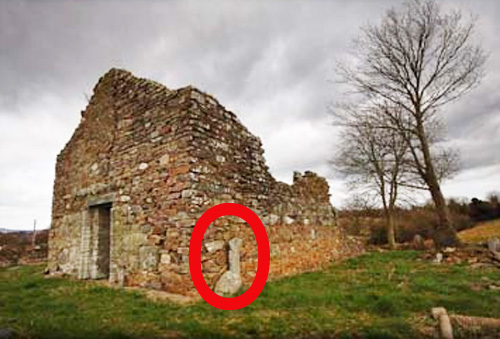
|
The ancient vertical
stone sundial (inside the red circle) in the ruins of the 12thc.
Clone Church, is the only remnant of the ancient monastery which preceded the
church at this site.
FROM
AUGUST 2011 THE CHURCH HAS BEEN FENCED OFF AND IS INACCESSIBLE. THE ANCIENT SUNDIAL
IS BEING STORED AT TINTERN ABBEY UNTIL FURTHER NOTICE.
UPDATE August 2019 The sundial is now on public display in the Visitor Centre at nearby Ferns Castle, Co. Wexford MJH |
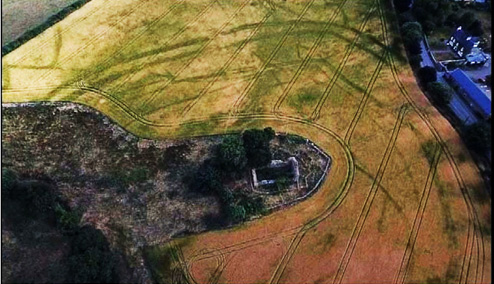
Drone photo by Dinny Kinsella
|
UPDATE September 2018: The following article and photo to the left has appeared in the local Wexford papers MJH
The Ferns Heritage Archive Group is currently
doing a lot of work at the ancient Clone church site and upon examining the area with a drone, local
archaeologist Barry Lacey was delighted to discover what could be evidence of an early monastic settlement.
‘There are multiple linear and curved features and which extend into the neighbouring field’ he explained.
‘These are likely the remains of dug features i.e. ditches or pits.
The most noticeable features in the field are the two parallel lines running adjacent to the church.
They appear in the overgrowth from behind it and travel towards the road were they appear to curve and disappear.
Interestingly at this point the boundary between the road and field is also curved and may suggest it once formed part of the same feature.
This feature is likely a monastic enclosure, a common feature of early monasteries with a majority dating from before 800AD.
It’s exciting because the church ruins in Clone are from the 12th century and it has always been thought an early
monastery associated with St. Aidan existed on the site and this discovery gives that theory much stronger credit’
|
UPDATE October 2019
A targeted geophysical survey was undertaken on the site. The survey revealed a pair of broadly concentric enclosures. The outer enclosure is c.3m wide separated by what was presumably once a bank (c. 6.0m wide). Approximately 25m inside the outer enclosure is an inner enclosure. The inner ditch is c.1m in width. Further analyses continue on a number of broadly radial enclosure elements throughout the area.
In Ireland early ecclesiastical sites were usually delimited by a
curvilinear enclosure, while in the case of important ones there can be two,
and in a few cases three, widely-spaced concentric enclosures. The symbolic
significance of this layout is explained in the early 8th century ‘Collectio
Canonum Hibernensis’:- ‘There ought to be two or three termini around a holy
place:
the outer, SANCTUS [holy], in which men who have been guilty of homicide, adulterers and prostitutes, with permission and according to custom, we do not prevent form going within’.
the middle, SANCTIOR[holier], into the streets the crowds of common people, not much given to wickedness, we allow to enter;
the inner sanctissimus [holiest], in which we allow no one at all to enter except priests,
because laymen do not come near it, nor women unless they are clerics. MJH
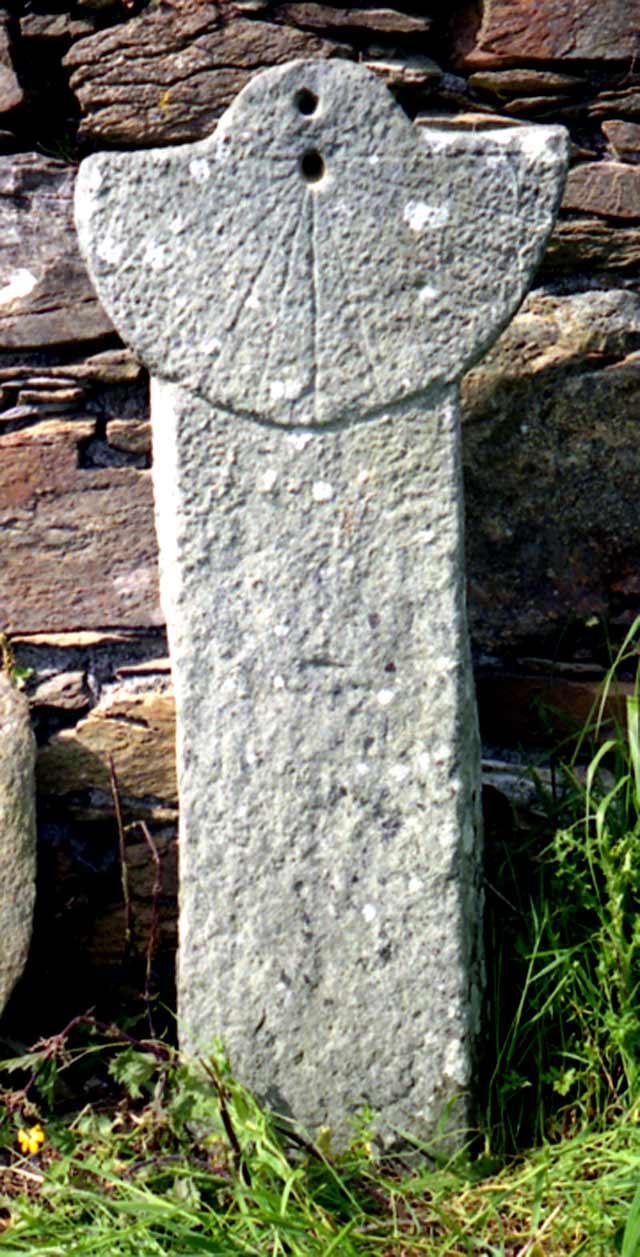
|
The 300mm wide by 100mm
thick "stem" of the sundial rises 950mm above ground. It branches out into a
500mm diameter semi-circular "bowl" shaped head with a 200mm diameter
semi-circular projection on the top. There are twelve timelines and nothing
remains of the gnomon but the hole where a gnomon would have fitted. The
function of the second hole in the top projection is a matter of conjecture.
|
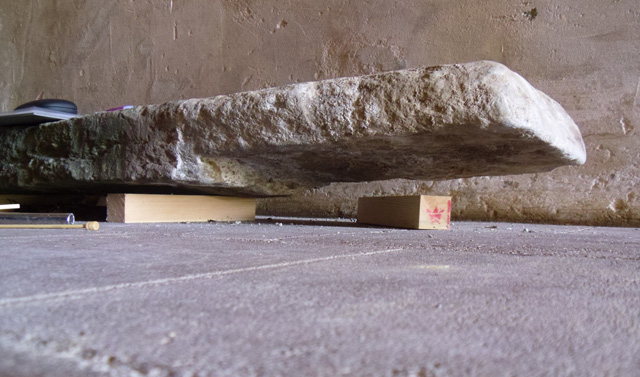
|
The end of the sundial
shaft (see opposite), which was buried in the ground at Clone, is now visible at Tintern Abbey
and had been shaped to fit into a socketed stone in much the same way as the
High Crosses were (see below).
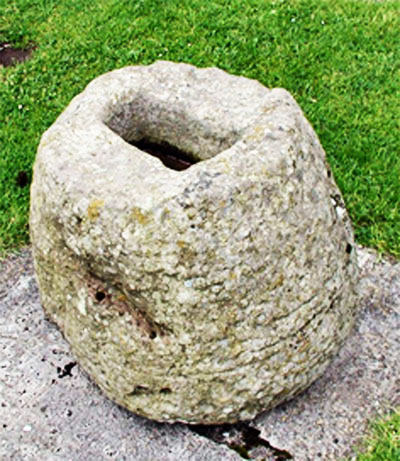
Socket stone at Kells, Co. Meath |
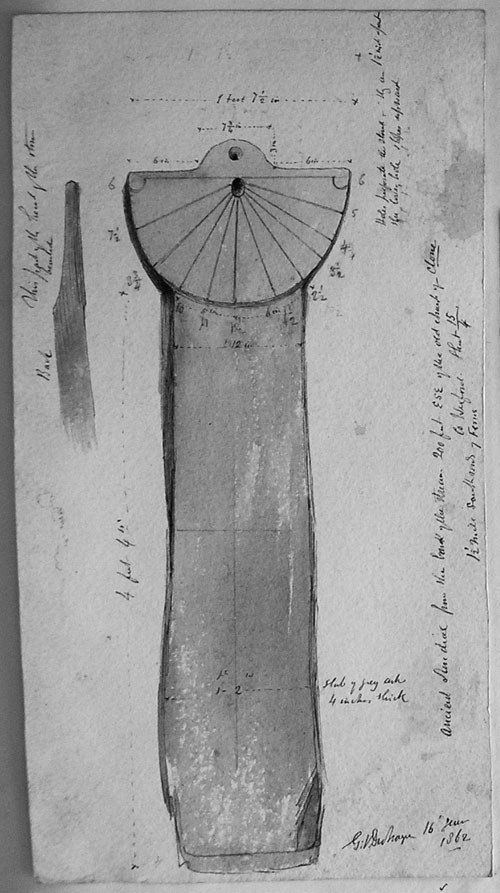
|
Drawing by the
Geologist/Antiquarian/Artist George V.Du Noyer 16th June
1862.
In addition to the detailed dimensions, notes on the drawing read
"Ancient Sun dial from the bank of the stream 200ft ESE of the old
church of Clone Co. Wexford. Sheet 15/4" "1½miles Southeast
of Ferns" "Back. This part of the stone beveled" "Holes
perforate the stone .....an 1½ inch apart. the lower hole slopes
upwards" "Slab of grey cist 4” thick"
|
Arriving in Ferns on the N11,
turn onto Station Road and then take the first right.
Drive 1.3 kilometres
and take the 2nd right onto Clone Road. The church is a further 800 metres in a
large field on the left.
Irish National Monument No. 665
British Sundial Society SR No 4220
Lat 52° 34' North
Long 6° 30' West
IRISH
GRID T
301430
147350
If you
know the location of a sundial in Ireland (NOT a mass produced
DIY Store garden ornament) please email it to me
(Click here to email
M.J.Harley) - a
member of British Sundial Society This site
is copyright M.J.Harley ©











